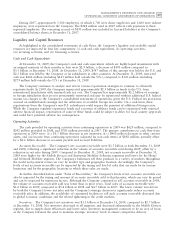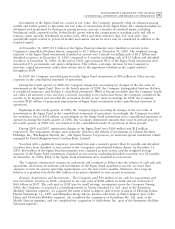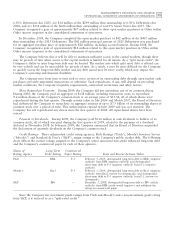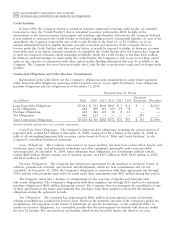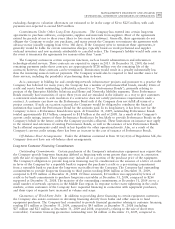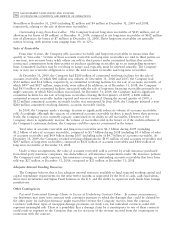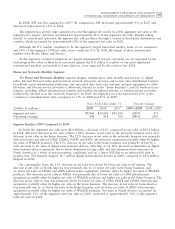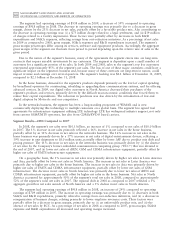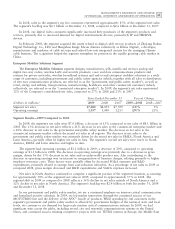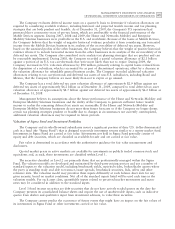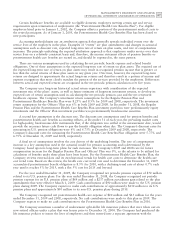Motorola 2009 Annual Report Download - page 66
Download and view the complete annual report
Please find page 66 of the 2009 Motorola annual report below. You can navigate through the pages in the report by either clicking on the pages listed below, or by using the keyword search tool below to find specific information within the annual report.
58 MANAGEMENT’S DISCUSSION AND ANALYSIS
OF FINANCIAL CONDITION AND RESULTS OF OPERATIONS
R&D is required and, even amidst challenging global economic conditions, the segment will continue to make the
appropriate investments to develop a differentiated product portfolio and fuel long-term growth.
The segment’s backlog (excluding any deferred revenue) was $409 million at December 31, 2009, compared
to $290 million at December 31, 2008. This increase in backlog is primarily due to an increase in orders in
North America, particularly for 3G products, including smartphones.
Unit shipments in 2009 were 55.1 million units, a 45% decrease compared to shipments of 100.1 million
units in 2008. The overall decrease reflects decreased unit shipments of products for GSM, CDMA and 3G
technologies, partially offset by an increase in unit shipments of products for iDEN technology. For the full year
2009, unit shipments decreased substantially in Latin America, EMEA and Asia and, to a lesser extent, decreased
in North America. While total unit shipments in the worldwide handset market decreased by approximately 6%
in 2009, unit shipments by the segment decreased by a significantly higher percentage than the overall market
decline.
In 2009, ASP increased approximately 8% compared to 2008. The overall increase in ASP was driven
primarily by changes in the product tier and geographic mix of sales, particularly in the fourth quarter of 2009
when the segment shipped approximately two million Android-powered smartphones. By comparison, ASP was
flat in 2008 and decreased approximately 9% in 2007. ASP is impacted by numerous factors, including product
mix, geographic mix, market conditions and competitive product offerings, and ASP trends often vary over time.
The segment has several large customers located throughout the world. In 2009, aggregate net sales to the
segment’s five largest customers accounted for approximately 54% of the segment’s net sales. Besides selling
directly to carriers and operators, the segment also sells products through a variety of third-party distributors and
retailers, which account for approximately 21% of the segment’s net sales. The loss of any of the segment’s key
customers could have a significant impact on the segment’s business.
Although the U.S. market continued to be the segment’s largest individual market, many of our customers,
and 42% of the segment’s 2009 net sales, are outside the U.S. In 2009, the largest of these international markets
were Brazil, China, Mexico and Korea.
Segment Results—2008 Compared to 2007
In 2008, the segment’s net sales were $12.1 billion, a decrease of 36% compared to net sales of $19.0 billion
in 2007. The 36% decrease in net sales was primarily driven by a 37% decrease in unit shipments. The segment’s
net sales were negatively impacted by the segment’s limited product offerings in critical market segments,
particularly 3G products, including smartphones, as well as very low-tier products. In addition, the segment’s net
sales were impacted by the global economic downturn in the second half of 2008, which resulted in the slowing
of end user demand. On a product technology basis, net sales decreased substantially for GSM and CDMA
technologies and, to a lesser extent, decreased for iDEN and 3G technologies. On a geographic basis, net sales
decreased substantially in North America, EMEA and Asia and, to a lesser extent, decreased in Latin America.
The segment incurred an operating loss of $2.2 billion in 2008, compared to an operating loss of $1.2 billion
in 2007. The increase in the operating loss was primarily due to a decrease in gross margin, driven by: (i) a 36%
decrease in net sales, (ii) excess inventory and other related charges of $370 million in 2008 due to a decision to
consolidate software and silicon platforms, and (iii) a $150 million charge in 2008 related to the settlement of a
purchase commitment, partially offset by: (i) the absence in 2008 of a $277 million charge for a legal settlement
recorded in 2007, and (ii) savings from supply chain cost-reduction initiatives. The decrease in gross margin was
partially offset by decreases in: (i) SG&A expenses, primarily due to lower marketing expenses and savings from
cost-reduction initiatives, and (ii) R&D expenditures, reflecting savings from cost-reduction initiatives. As a
percentage of net sales in 2008 as compared to 2007, R&D and SG&A expenses increased and gross margin
decreased.
The segment’s backlog (excluding deferred revenues) was $290 million at December 31, 2008, compared to
$647 million at December 31, 2007. This decrease in backlog is primarily due to a decline in customer demand,
primarily driven by the segment’s limited product portfolio, as well as the global economic downturn.
Unit shipments in 2008 were 100.1 million units, a 37% decrease compared to shipments of 159.1 million
units in 2007. The overall decrease reflects decreased unit shipments of products for all technologies. For the full
year 2008, unit shipments decreased substantially in North America, EMEA and Asia and, to a lesser extent,
decreased in Latin America. Although unit shipments by the segment decreased in 2008, total unit shipments in
the worldwide handset market increased by approximately 5%.



